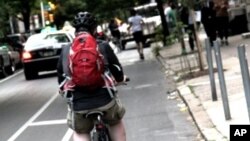With gasoline prices prices in the United States hovering around $1 per liter, the number of bicyclers is increasing, especially in cities, according to the AAA Fuel Gauge Report.
Sales of road bikes in the United States are up 29 percent from just a year ago, according to Leisure Trends Group, a retail tracking firm. That comes as no surprise to bicyclist Andy Clark.
"Most people know and remember cycling as being great fun," he says. "Everyone had fun and remembers the wind blowing through their hair when they rode their bikes as kids. What they’re missing is that same sense of freedom and excitement and fun."
But Clark, president of the national advocacy group League of American Bicyclists, says it’s often hard to recapture that sense of fun when you’re biking to work in the street. Sharing wide roads designed for faster, larger gas-powered vehicles is not just intimidating, it's also dangerous.
So when local governments began making street safety a priority, bicyclists responded by taking to the city’s streets in droves, says Andrew Stober, who is with Philadelphia’s Transportation office.
"Just a few years ago, there weren’t that many cyclists out there," he says. "But because of higher oil prices, an increased focus on staying fit and healthy, and government doing things to make it easier than ever before to bike, (bikers) have company on the streets."
The League of American Bicyclists recently designated almost 200 communities in 44 states as "bike-friendly." That’s a 25 percent increase from a decade ago. League president Clark says that's because more cities across the country are adapting to the cycling trend by adding dedicated bike lanes on major roads and installing bike racks on sidewalks. Boston paved 32 kilometers of bike lanes last year. New York City added more than 80.
"We’re seeing certainly infrastructure on the streets going in - bike lanes, and trails, and cycle tracks - and a lot of European-style infrastructure being tested in the U.S. for the first time in decades," says Clark.
In Philadelphia, more than 600 kilometers of bike lanes have been added over the past year, stretching in all directions across the city.
"The heart of why I love bicycling is the fact that I look forward to the end of the day, here comes my commute," says Alex Doty, executive director of the Bicycle Coalition of Philadelphia. He adds that the costs of purchasing and maintaining a bicycle are significantly lower than those of owning a car. "Some of us who’ve been doing this for a while, we start getting into a more expensive bike. But you can start out with something for $100, and there you go."
And bicycling isn’t just an inexpensive option for commuters, says Kate Powilson, with the national advocacy group BikesBelong. It’s a good deal for cities, too.
"Cities are realizing the benefits of bicycling, because in this economic climate, there's not a lot of money in budgets to build new roads and to expand light rail and subways," says Powilson. "And, so, bicycling is a really cheap way to move people."
And it doesn’t appear to significantly slow down traffic.
Bicycle commuting in America has more than doubled since 2000. In Philadelphia, more than 10,000 commuters choose pedal power to get to work every day, according to the Bicycle Coalition of Greater Philadelphia. That number is expected to grow during the summer months, especially if gas prices continue to rise. Last Friday was National Bike-to-Work Day. Mayors, officials and lawmakers in hundreds of cities across the country joined thousands of their citizens on two wheels, to highlight the popularity - and practicality - of bicycle commuting.











